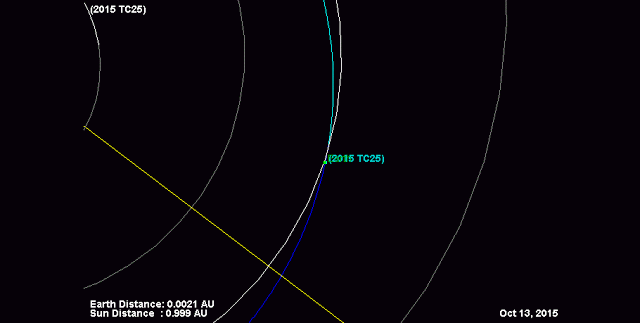Radar imaging of asteroid 2015 TC25 from University of Arizona on Vimeo.
Arizona astronomers are reporting this week on observations made a year ago of what they say is the smallest asteroid yet observed and characterized in detail. Asteroid 2015 TC25 is only 6 feet (2 meters) in diameter – about the height of a man – and so, as they said in their November 30, 2016 statement:
… the tiny space rock is small enough to be straddled by a person in a hypothetical space-themed sequel to the iconic bomb-riding scene in the movie Dr. Strangelove.
These are the kinds of things astronomers think about, late at night, while spending hour after hour in dark telescope domes. But it is a graphic image for the tiniest asteroid!
2015 TC25 passed by Earth on October 13, 2015 at a distance of about 0.3 lunar-distances (about a third the distance between us and the moon). Astronomers were estimating a 5-meter diameter for the asteroid at the time.
It missed us, of course, by approximately 80,000 miles (128,000 km), and astronomers had said at the time that – even if it had been on a collision course with Earth – 2015 TC25 would have burned up in Earth’s atmosphere, as so many other incoming space rocks do.
Read more: 26 atom-bomb scale asteroid impacts since 2000

The group from Arizona now report that asteroid 2015 TC25 is also one of the brightest near-Earth asteroids ever discovered. Using data from four different telescopes, a team of astronomers led by Vishnu Reddy, an assistant professor at the University of Arizona’s Lunar and Planetary Laboratory, says that 2015 TC25 reflects about 60 percent of the sunlight that falls on it. Their November 30 statement said:
Discovered by the UA’s Catalina Sky Survey last October, 2015 TC25 was studied extensively by Earth-based telescopes during a close flyby that saw the micro world sailing past Earth at 128,000 kilometers, a mere third of the distance to the moon.
In a paper published in The Astronomical Journal, Reddy argues that new observations from the NASA Infrared Telescope Facility and Arecibo Planetary Radar show that the surface of 2015 TC25 is similar to a rare type of highly reflective meteorite called an aubrite. Aubrites consist of very bright minerals, mostly silicates, that formed in an oxygen-free, basaltic environment at very high temperatures. Only one out of every 1,000 meteorites that fall on Earth belong to this class.
Reddy added:
This is the first time we have optical, infrared and radar data on such a small asteroid, which is essentially a meteoroid.
You can think of it as a meteorite floating in space that hasn’t hit the atmosphere and made it to the ground — yet.
Astronomers nowadays watch for and discover near-Earth asteroids such as 2015 TC25 frequently, but not very much is known about them as they are difficult to characterize. By studying such objects in more detail, astronomers hope to better understand the parent bodies from which these meteorites originate.
In their decades-long effort to understand how our solar system formed, astronomers have come to see asteroids as the remaining fragments from solar system formation. Most of the asteroids we know orbit the sun between the orbits of Mars and Jupiter, but some do pass near Earth and cross Earth’s path. So far, more than 15,000 near-Earth asteroids have been discovered.
Scientists are interested in objects like this in part for the pure science they offer; they can give us insights into our solar system’s birth and history.
Increasingly, however, astronomers have come to study near-Earth asteroids because these are the objects that have potential to strike Earth.
Read more about 2015 TC25 from University of Arizona
Read more: Arizona-based Astronomers Characterize One of the Smallest Known Asteroids
Bottom line: Arizona astronomers report this week on observations made a year ago of 2015 TC25, which they say is the smallest asteroid yet observed and characterized in detail. Asteroid 2015 TC25 is about 6 feet (2 meters) in diameter.











